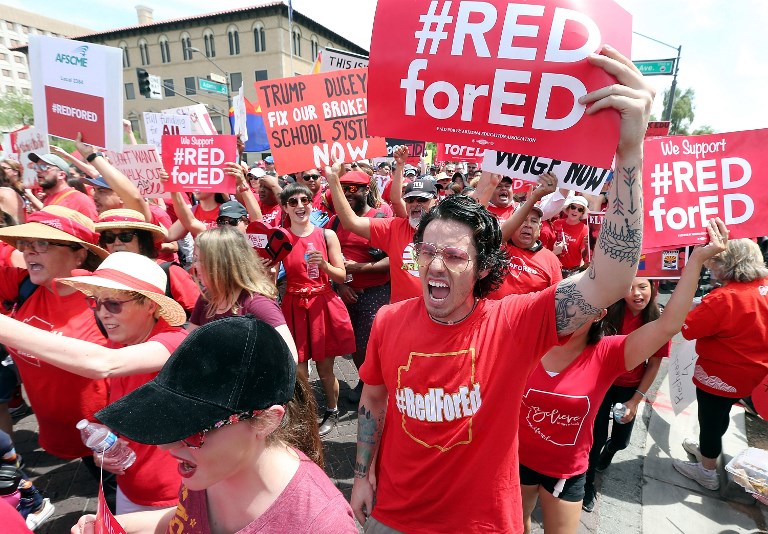In early June, political scientist and labor scholar Paula Varela interviewed scholar and activist Charlie Post about the teachers’ strike wave, the possibilities of spreading the strike wave to blue states or to other industries and the strikes’ implications for the left.
This interview was conducted before the Supreme Court ruled on the Janus v. AFSCME case.
The Teachers Spring has had an impact on the debates about the situation of the working class in the United States, and it has forced everyone on the left to talk about the working class again. That’s a very good thing. What are the main characteristic of the Teachers Spring? What sets it apart from previous labor struggles?
Well, there are four things that may distinguish these strikes from previous strikes of the last 40 years. The first is that they are all illegal. All of them violated the state laws against public sector workers striking in the United States. Almost every state bans them. There’s a couple of states, like Illinois and California, where public sector workers can strike legally, but in the right-to-work states in the South, New York, etc., these are all illegal strikes. These teachers could have all been fired en masse, or a court could have issued injunctions against the strike, and they could have been jailed. Yet they went out and stayed out.
Second, these were mostly unauthorized strikes. They were initiated by rank-and-file groupings, stronger or weaker–stronger in West Virginia and in Arizona, weaker in Oklahoma, Kentucky and North Carolina–that had developed real roots in the schools. These networks of what in other countries would be called shop stewards or building representatives,, prepared these strikes over a series of months, escalating actions, and called these strikes without the official permission of their union leaders, and, where they had to, particularly in West Virginia, continued to stay out against the wishes of their leaders. In Arizona, basically, they forced the leaders to follow.
Were the teachers aware of the consequences of striking illegally?
Yes, I assume they were aware of the consequences. But I think they were also betting, particularly in West Virginia, that they could safely strike because there’s been a severe teacher shortage as a result of the terrible pay. Even though the cost of living is much lower than in cities like New York, Chicago and Los Angeles, people can’t make ends meet. There’s been a chronic shortage of teachers. They were dropping the professional requirements to be a K-12 teacher, so they knew that it would be very difficult to replace them.
They also had the support, in West Virginia at least, of other nonteaching school personnel, particularly the bus drivers. Because unlike New York, most kids in West Virginia can’t take the metro to school. They rely on these buses. So I think they were very aware of this, but particularly in West Virginia, they calculated that it would be very difficult to replace them.
The third characteristic is that it was an actual strike wave. This is the first strike wave since the late 1970s, where one strike inspires another strike that inspires another strike. I would not be surprised if we see strikes again by late September or October, when teachers return to work. Because the fourth feature is the most important: two of these strikes won. One could argue that the 2012 Chicago teachers’ strike was a partial victory. The clearest victory before that was the UPS strike in the late 1990s. And that was the result of 30 years of organizing by Teamster militants in Teamsters for a Democratic Union. But it didn’t inspire strikes. So it’s the four things — they were illegal, they were unauthorized, they actually sparked a strike wave and they were successful. I think this really changes things for the radical left and for the labor movement generally.
You now have labor bureaucrats, particularly in the teachers’ unions, scrambling to keep up. This includes the American Federation of Teachers (AFT), which organizes most of the large urban school districts, like New York and Chicago. They also organize a lot of the public sector universities, like CUNY, the union I am affiliated with. And it includes the National Education Association, which is much larger. Initially it wasn’t a trade union, it was a professional association. It became a trade union in the 1950s and 1960s in competition with the AFT, and it tends to dominate in suburban schools and has a presence in certain universities and colleges. The bureaucracies are now scrambling to put people in place. In West Virginia, they had maybe one or two staffers. It was incredible. One can make he parallel between the sort of weakness of a reformist bureaucracy in Russia in 1917 and the strength of the German Social Democracy. They had no apparatus. There were maybe four or five staffers between the two unions, statewide. In Arizona they had a bit more of a presence, and, also, they basically followed the rank and file. In Oklahoma and elsewhere, they were a bit stronger.
But they’re scrambling. And whole layers of former reformers, basically people who appear to be left bureaucrats, are all now saying, “Oh yes, this is inspiring,” but they are doing everything they possibly can to say, “It can’t work in my local.” So, for example, the leadership of my union said, “This is great.” We support them, etc., but they have several articles and letters in The Clarion, the union newspaper, explaining why we can’t do this in New York.
And clearly it is going to be much more difficult to replicate the teachers’ strike in a state where there is collective bargaining and a stronger bureaucracy. And where there is much stronger tradition of district- or university-wide bargaining rather than state-wide bargaining. But for me, at least in our union, it gives an opportunity to say, “Let’s talk about what we need to do to get to that point.” And I know that people in the Movement of Rank and File Educators (MORE) in the K-12 union, United Federation of Teachers (UFT), are carrying out a campaign around the question of what it will take to pose a credible strike threat.
It will not be as simple as it was in West Virginia. We have a lot more membership passivity, a lot more people saying, “Well, that’s what the union is supposed to do for us,” rather than “We do for ourselves.” And you have a very strong bureaucracy, particularly in New York. The UFT, a union of 80,000 teachers and another 40,000 or 50,000 other school workers, nurses, home health care aides, etc. They’re one of the largest local unions in the country. They have like 160,000 members. But only 80,000 or 90,000 are school workers. They probably have 300 or 400 staffers. These are the people you have to rely on as soon as your grievance goes beyond the building. So they’re going to be a much bigger obstacle, but I don’t think it’s impossible to overcome it.
The teachers’ strikes were concentrated in red states. Does this point to disappointment in the Trump government? Or did they take place there mainly because the union bureaucracies are weak in those states?
Particularly in West Virginia, there were a lot of teachers who voted for Trump. West Virginia is a really good example of what’s been going on in U.S. politics. In May 2016, [Bernie] Sanders trounced Clinton in West Virginia’s Democratic primaries. He got close to 60% of the vote. He won every county in West Virginia. Four or five months later, in the general election, the state goes overwhelmingly for Trump. Teachers who had voted for Trump went out because they felt like, “He’s been there for a year. He’s done nothing for us, and he’s done nothing for the coal industry.”
This is because the teachers in West Virginia, particularly in the southern part of the state, are dealing with the social effects of the coal industry’s collapse. They’re dealing with kids whose parents are addicted to opioids, who are being raised by their grandparents. These are problems that most school teachers in big cities saw for years among their students from racially oppressed groups in the working class. They’re now seeing these problems among kids whose fathers, 10 or 15 years ago during the coal boom, could be bringing home $100,000 a year with overtime. So they’re dealing with all this, and a lot of them are saying, “Trump promised us a reversal, and things are not happening.” Teachers in many of these states are working not just second but third jobs, and they’re deeply, deeply in debt.
It’s a combination of the disappointment with Trump and the union officials’ weakness, and the presence, particularly in Arizona, in West Virginia, of small groups of self-conscious socialists — comrades in the left wing of DSA. They may be confused on the Democratic Party and the transition to socialism, but they’re very clear on the union bureaucracy, they’re very clear on rank-and-file self-activity, and many of them are now very concerned about getting pulled into electoral politics. That, combined with widespread disaffection and the weakness of the union bureaucracy, made this sort of breakthrough possible.
The Democratic Party in states that they dominate relies on the labor movement, not so much for funding, but the unions, particularly public sector unions, are the only organization that can provide people to ring doorbells and get out the vote. They discovered in 2016 that where they didn’t do that in key midwestern states, they lost by a razor-thin margin to Trump. In New York State, Governor Andrew Cuomo relies on the building trades unions, AFL craft unions, and the public sector unions to go out and make sure he gets reelected. And even though the teachers unions have not endorsed him in a couple of elections, the reality is, lots of Democrats who run for the state legislature are very dependent on these folks. This is why they’re opposed to attempts to weaken public sector unions. They’re opposed to open shop. Because this would mean that the union as an institution would be much weaker, and they don’t have folks to go out there. It also means that the union bureaucracy in these states is even more conservative because it firmly believes that, despite being shat on continuously by the Democrats, like Cuomo, their alliance with the Democrats is their only hope.
So between these two forces, between the Democratic Party and the union officials, it’s going to be a big pushback, and we may not see strikes in New York, we may see them in California, we may see strikes again in Illinois. New York: it’s going to be a longer process of rebuilding a militant minority. It may not be this contract, but maybe the next contract, when there’ll be enough activity to actually force the leadership on a strike. I know a lot of the militants in MORE are studying the 1975 teachers’ strike, which was called by the delegate assembly against the wishes of the leadership of Albert Shanker. They were able to force the leaders to go out on strike, but they couldn’t take control of the strike. So when Shanker came back after a week or so and said, “This is the best I could get,” they organized the Vote No campaign, but they didn’t have the strength to defeat the contract and stay out. That’s going to be the big challenge.
The teachers are a unique sector of the working class because they have a close relationship with the community, with the parents. Do you think a strike wave originating among teachers could spread to the private sector, the industrial sector?
In a number of states, such as in West Virginia, telecommunications workers organized by the Communication Workers of America (CWA) went out in support of the teachers. The CWA is led by a left bureaucracy. They’re willing to engage in very conventional strikes, and there’s been a history of rank-and-file groupings within various unions. So it did inspire it there. There was a big telecom strike on the East Coast in 2016 that ended in a partial victory. The problem is that for this to have a real resonance among private sector workers, you’d have to have more developed opposition groupings, rank-and-file groupings in those unions.
So, at this point, the most likely place you’re going to see some pushback is at UPS. They’re negotiating a contract. Teamsters for a Democratic Union has some strength there, and people are very pissed off that the Teamsters leadership is willing to make all sorts of concessions, particularly on both wages and conditions for the part-time workers who do the sorting at the big barns, and pensions, which is a big issue for the drivers, who tend to be full time workers and a bit old. So there’s some possibility that there’ll be some echo with UPS. It’s not clear. Otherwise, there is no organized opposition beyond a few networks of websites, mostly run by retirees in the auto industry. The reform movement New Directions, which was fairly powerful in the early 1990s, got smashed. So there’s not much going on there.
In the steel workers, which incorporate a lot of the ex-CIO unions, there hasn’t been an opposition since 1978, 1979, around Ed Sadlowski, who was a district rep, a leftie, who opposed five-year contracts, no-strike pledges, etc. So in those unions, there’s not much going on. I think it will have a very positive effect in the nurse’s unions. I think it will encourage people in the nurse’s unions who are talking about strike activity, etc. The big question is what effect will it have on the handful of people who are doing long-term organizing in the predominantly nonunion logistics industry. And that’s unclear at this point.
Kim Moody, my comrade who’s living in London, interviewed a bunch of those people, and a lot of them are very encouraged by the teachers’ strikes, but it’s not immediately manifesting itself. And even there, you’re talking about basically the UE [United Electrical, Radio and Machine Workers of America], which used to be one of the larger unions. They’ve got 50,000 or 60,000 members. They have a couple of contracts at some machine shops, and they are willing to do the sort of long-term organizing outside the framework of national labor relations law, which is necessary to organize that industry. But they’re small and have limited resources. What’s interesting is, there’s a lot of interest among a layer of young DSA members in going into the logistics industry.
The thing is, these are really shitty jobs. You’re working 50, sometimes 60 hours a week. You’re barely making enough to get by. The working conditions are terrible, and for people to go in would require a very long-term commitment and a strong set of organizers, a political organization behind them. So that’s the big limit there in terms of how it’s going to translate. It will be interesting to see how it works out, what impact it has on the UPS negotiations, and then it’ll be interesting to see if there’s greater activity among nurses and health care workers. And there has been greater activity in the last couple of years.
Could the Janus decision open a possibility for the left?
Six or eight months ago, I would’ve said that the comrades who argued this were being ultraleft and spontaneous, etc., because while Janus would weaken the union bureaucracy, there was an insufficient level of self-activity among a significant minority of the ranks of labor today. But Janus might, in some areas, open up some real possibilities by weakening the union bureaucracy’s hold over workers.
Janus has already forced certain union bureaucracies to try harder to get people to commit to staying members, etc. But today what it opens are new discussions about the lack of exclusive bargaining rights. Does this mean we still have to abide by the no-strike pledge, where we don’t strike during the contract term? Does it mean we continue to be bound by the laws that restrict our ability to strike when the contract expires? It could begin to open these questions in the light of the teachers’ strike wave. And again, whether it will open opportunities or not depends less on the direct impact of Janus and more on the existence of a significant layer of people who can fill this opening.
At one point during the teachers’ strike wave, I actually thought that if this continues, the Supreme Court might rule against Janus. The AFL-CIO in an amicus curiae brief to the Supreme Court basically said, “If you repeal this [the right to collect agency fees], you’re going to see more of these strikes.” You know, “You gave us this shit during the Second World War to clamp down on this sort of strike activity. Do you really want to open the floodgates?” The right felt that labor was completely prostate, and it was not going anywhere. It will be interesting to see what happens. But again, I think the key thing will be whether, in different industries, different workplaces, different sectors, there are networks of activists who say, “This means we have to be more active, more militant, more self-organized.”











